All program notes by Julie Giroux (https://www.juliegiroux.org/)
I. Mount Fuji - "Fuji-san"
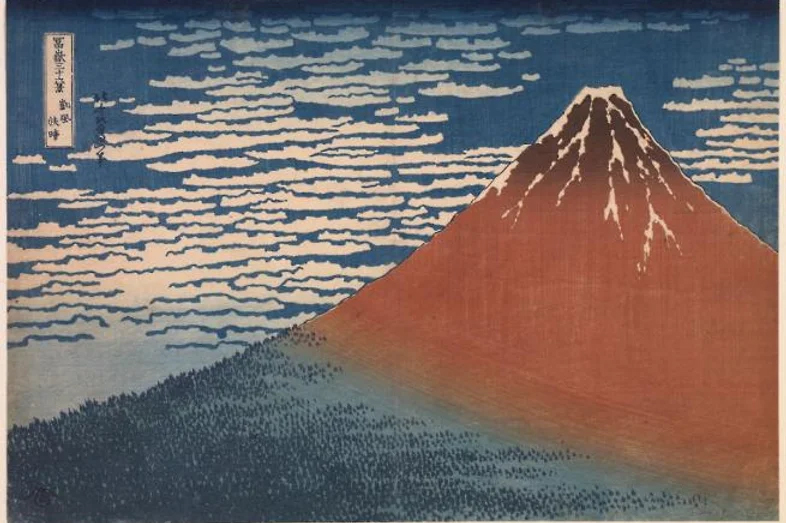 Based on the bookmark "Fine Wind, Clear Morning" by Hokusai Katsushika which is a woodblock sketch from Hokusai's collection - The 35 Views of Mt. Fuji.
Based on the bookmark "Fine Wind, Clear Morning" by Hokusai Katsushika which is a woodblock sketch from Hokusai's collection - The 35 Views of Mt. Fuji.
PROGRAM NOTES
The sketch Fine Wind, Clear Morning (Gaifu kaisei), also known as South Wind, Clear Sky or Red Fuji, by Hokusai Katsushika is the inspiration for this work which is subtitled "Fuji-san." In early autumn when, as the original sketch title specifies, the wind is southerly and the sky is clear, the rising sun can turn Mount Fuji red. Fuji-san has many different looks depending on the viewer's vantage point, time of year, weather and even time of day. Big, bold and easily recognized yet shrouded in mystery and lore, Mount Fuji offers a multitude of inspirational facets. This piece is based on one view of Mt. Fuji covered in mist and low clouds which slowly burns off as the day progresses.
Orchestration and composition techniques follow this scenario starting off with mysterious, unfocused scoring. As the piece progresses, the scoring gets more focused and bold with the final statement representing Fuji-san in a totally clear view.
II. Nihonbashi - "Market Bridge"
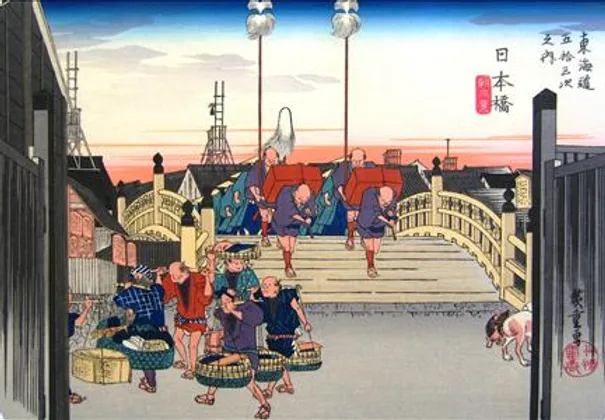 Based on the bookmark "Nihonbashi" by Hiroshige Ando which is from the print series - The 53 Stations of the Tokaido Highway
Based on the bookmark "Nihonbashi" by Hiroshige Ando which is from the print series - The 53 Stations of the Tokaido Highway
PROGRAM NOTES
Hiroshige Ando (1797-1858) traveled the Tokaido from Edo to Kyoto in 1832. The official party he was traveling with were transporting horses which were gifts to be offered to the Imperial court. The journey greatly inspired Hiroshige for he sketched many of its scenes during his round trip travels. In all, Hiroshige produced 55 prints for the series The Fifty-Three Stations of the Tokaido. Fifty three of the prints represent each of the 53 post stations along the way. The two additional prints are of the starting and ending points. The post stations offered food, lodging and stables for travelers of the Tokaido Highway.
This is Hiroshige's "Leaving Edo : Nihonbashi", "the bridge of Japan" and is number 1/55 in the series of prints.
The Nihonbashi bridge was the central point of development of which is now a business district of Chuo, Tokyo, Japan aptly named the Nihonbashi District. For centuries it thrived as a mercantile district. The first department store ever developed in Japan was by the Mitsui family named Mitsukoshi. From its early days as a fish market to the current financial district of Tokyo (and Japan), this bridge spanning the Nihonbashi River is a true landmark in Tokyo. In fact, highway signs that state the distance to Tokyo actually state the distance to the Nihonbashi bridge. Up until shortly before 1964, you could see Mount Fuji from the bridge however the 1964 Summer Olympics put in a raised expressway over the Nihonbashi bridge, obscuring its view entirely. Petitions to relocate the expressway underground in order to regain view of Mount Fuji are continuous but so far have been futile due to the costs for such a project.
III. The Great Wave off Kanagawa - "The Life of One Wave"
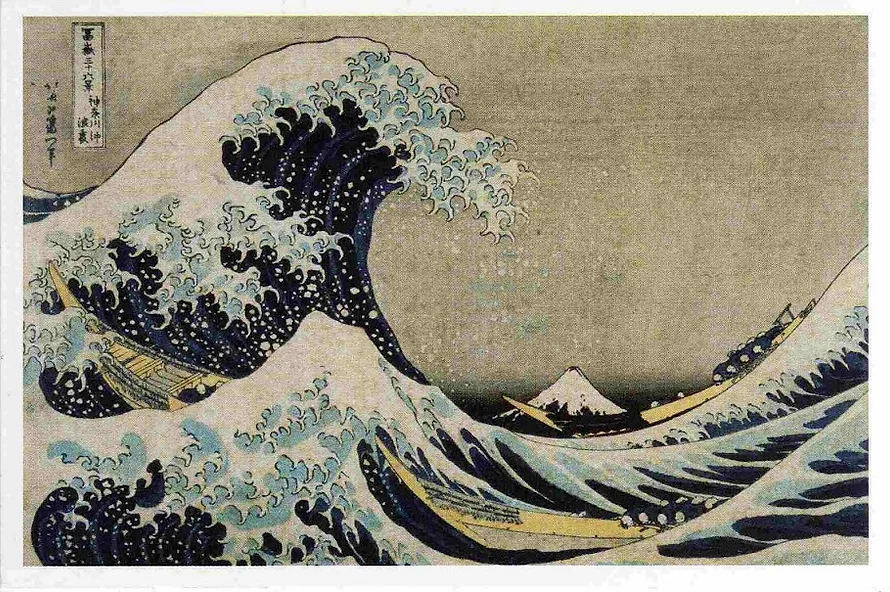 Based on the bookmark "The Great Wave off Kanagawa" by Hokusai Katsushika which is from Hokusai's collection - The 35 Views of Mt. Fuji.
Based on the bookmark "The Great Wave off Kanagawa" by Hokusai Katsushika which is from Hokusai's collection - The 35 Views of Mt. Fuji.
PROGRAM NOTES
The artwork of Hokusai is well known and this particular woodblock print which was published between 1830 and 1833 is well known throughout the world. His series Thirty-six Views of Mount Fuji is Hokusai's most famous work. Looking at this stunning print, you can see Mount Fuji in the background but the central focus is an enormous wave called an okinami (wave of the open sea) peaked and curling with several Japanese boats in different stages entering the perilous wave.
In this work, a single wave is depicted from its beginnings far out in the sparkling sun drenched seas all the way through its final throes onto a rocky beach. The piece starts in the open sea, fairly calm with sunlight refracting into thousands of tiny points of light. Depicting this are the woodwinds rippling up and down with sixteenth triplet variations. The trombones and french horns enter the mix with a solid melodic statement. The trumpets add in near the end of the phrase all of which depicts the first shaping of the great wave. This entire section peaks in measure 38 where we get the full rolling motion throughout the entire band. Just looking at the score, you can see the melodic lines and phrases going up and down the staves.
From measures 40 to 45 the music winds down, ending with only 2 instruments playing. This signifies the separation of the wave from the open sea as it begins its final path towards landfall. Measure 45 to the end is its journey, growing in strength and volume to the final moments of this great wave.
IV. Kinryuzan Temple in Asakusa - "Thunder Gate"
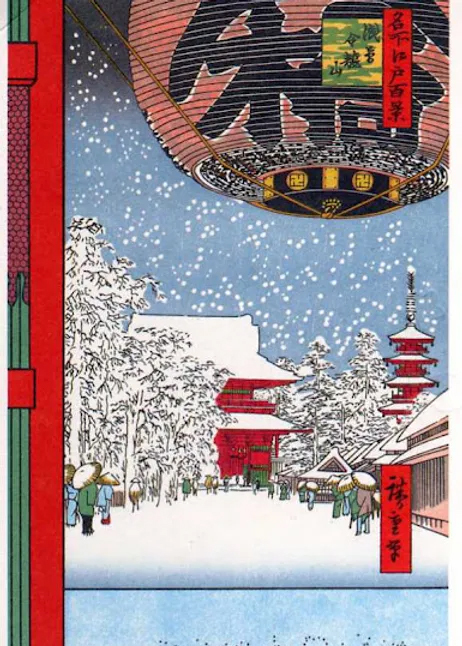 The name of the print on the bookmark says Kaminari-mon Gate of Asakusa Kannon Temple but the true name of the print is "Kinryuzan Temple in Asakusa" by the artist Hiroshige Ando. Hiroshige died before the entire collection was completed. Hiroshige II finished it. The first prints were published in order between 1856 and 1859.
The name of the print on the bookmark says Kaminari-mon Gate of Asakusa Kannon Temple but the true name of the print is "Kinryuzan Temple in Asakusa" by the artist Hiroshige Ando. Hiroshige died before the entire collection was completed. Hiroshige II finished it. The first prints were published in order between 1856 and 1859.
The Temple History
Originally built in 941 AD, Kaminarimon is the outer gate leading to the Senso-ji Temple which was constructed around 628 AD near Kamagata and later relocated to its present location in Asakusa, Tokyo, Japan in 1635. This large gate features 4 statues. The Shinto gods Fujin and Raijin are located on the front of the gate and the Buddhist god Tenryu and goddess Kinryu stand on the reverse side. Fujin displayed on the front east side of the gate is the god of wind and Raijin on the west side is the god of thunder giving the gate its nickname of “Thunder Gate.”
Displayed in the middle of the gate is a giant red chochin (lantern) which weighs approximately 1,500 pounds. Despite its huge size, it is very fragile. The front of the lantern bears the painting of the gate’s name Kaminarimon, and the painting on the back reads Furaijinmon, the official name of the gate. The bottom or base of the chochin displays a beautiful wooden carving of a dragon. Over the centuries the gate has been destroyed and rebuilt many times. The current gate dates to 1960 and the new lantern was donated in 2003.
As a tourist, you cannot get close to the statues as they are protected by fences and wire and you certainly cannot touch them. Despite all of that, the magnificence of the gate still shines through, bearing testament to centuries of humans that have passed through its structure and the centuries yet to come.
V. "Evening Snow at Kambara" - "Light is the Touch"
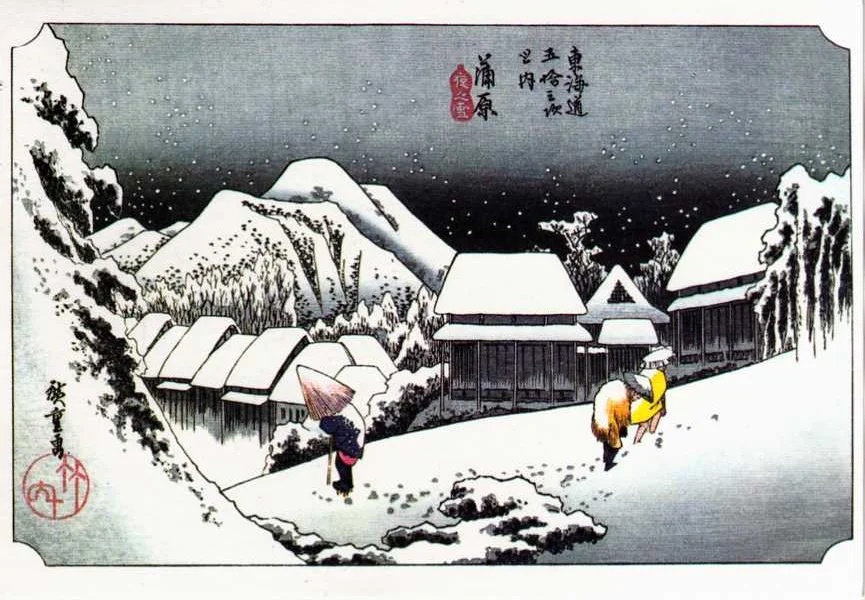 Based on the bookmark "Evening Snow at Kambara" by Hiroshige Ando which is from the series The 53 Stations of the Tokaido Highway.
Based on the bookmark "Evening Snow at Kambara" by Hiroshige Ando which is from the series The 53 Stations of the Tokaido Highway.
PROGRAM NOTES
Hiroshige Ando (1797-1858) traveled the Tokaido from Edo to Kyoto in 1832. The official party he was traveling with were transporting horses which were gifts to be offered to the Imperial court. The journey greatly inspired Hiroshige for he sketched many of its scenes during his round trip travels. In all, Hiroshige produced 55 prints for the series The Fifty-Three Stations of the Tokaido. Fifty three of the prints represent each of the 53 post stations along the way. The two additional prints are of the starting and ending points. The post stations offered food, lodging and stables for travelers of the Tokaido Highway.
This is Hiroshige's "Leaving Edo : Nihonbashi", "the bridge of Japan" and is number 1/55 in the series of prints. The Nihonbashi bridge was the central point of development of which is now a business district of Chuo, Tokyo, Japan aptly named the Nihonbashi District. For centuries it thrived as a mercantile district. The first department store ever developed in Japan was by the Mitsui family named Mitsukoshi. From its early days as a fish market to the current financial district of Tokyo (and Japan), this bridge spanning the Nihonbashi River is a true landmark in Tokyo. In fact, highway signs that state the distance to Tokyo actually state the distance to the Nihonbashi bridge. Up until shortly before 1964, you could see Mount Fuji from the bridge however the 1964 Summer Olympics put in a raised expressway over the Nihonbashi bridge, obscuring its view entirely. Petitions to relocate the expressway underground in order to regain view of Mount Fuji are continuous but so far have been futile due to the costs for such a project.
VI. Hakone - "Drifting"
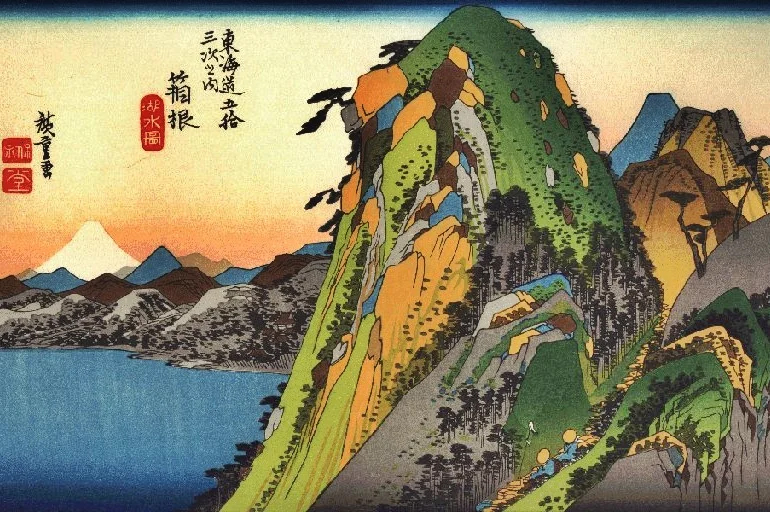 Based on the bookmark entitled "Hakone Pass" which is based on the actual print by Hiroshige Ando called "Hakone" which is from the print series The 53 Stations of the Tokaido Highway.
Based on the bookmark entitled "Hakone Pass" which is based on the actual print by Hiroshige Ando called "Hakone" which is from the print series The 53 Stations of the Tokaido Highway.
PROGRAM NOTES
Hiroshige Ando (1797-1858) traveled the Tokaido from Edo to Kyoto in 1832. The official party he was traveling with were transporting horses which were gifts to be offered to the Imperial court. The journey greatly inspired Hiroshige for he sketched many of its scenes during his journey's round trip. In all, Hiroshige produced 55 prints for the series The Fifty-Three Stations of the Tokaido. Fifty three of the prints represent the 53 post stations along the way. The additional 2 prints are of the starting and ending points. The post stations offered food, lodging and stables for travelers of the Tokaido Highway.
Hakone-juku was the tenth of the fifty-three stations of the Tokaido. At an elevation of 725m, it is the highest post station on the entire Tokaido offering spectacular views. Hakone-juku was established in 1618 and over the years has proven to be a hard road to maintain due to its elevation.
THE MYSTERY
When I started researching Hakone there wasn't much of anything striking a chord within my creative self. Just a city that had a long road with lots of curves, switchbacks and other hazards passing through it. It wasn't until I looked at the actual highway on a map that it rang a bell. I had seen this road before. I truly recognized the shape of the entire highway.
Having never been on that actual highway in real life I knew I had to unravel the mystery. A few more searches on the internet and there it was. I am an avid "gamer" and though I tend to play all types of games both on the computer and on consoles, I have always played racing games and that is where I had "driven" it before, in a video game. The drifting I did on that highway in the game mostly sent me sailing off the road, flying through air and ultimately landing in a fiery, end over end wipeout. And as with any search on the internet, Youtube offered up a seemingly endless supply of videos featuring not one, but long parades of cars in single file drifting on the Tokaido Highway as it runs through Hakone.
THE MUSIC
Subtitled "Drifting" this piece reflects my love of fast cars doing crazy fun things. In this instance that would be drifting. Drifting is the art of manipulating the brakes, the gas and precise steering wheel positioning keeping the car in a controlled skid/slide while traveling around curves. The music depicts the adrenaline racing, heart pumping action of drifting cars on the Tokaido Highway through Hakone and beyond. It is fast, furious, full of odd meters and features nearly every instrument in the band at least once. My version of musical drifting. Lets just hope there are no wipeouts or fiery crashes.
INSPIRATION
Molly & Ray Cramer gave me a set of 6 bookmarks they had purchased in Japan. Each paper bookmark had beautiful color sketches of scenes or places by famous Japanese artists. They gave them to me during a lunch outing we took together while at a convention. I did not eat much of my lunch because I could not stop looking at the bookmarks. My imagination was whirling with each scene painted on each bookmark. I knew right then and there that those 6 little bookmarks would be the subject of my next symphony.
And sure enough, those 6 little pieces of paper with their tiny little purple silk strings consumed the better part of 6 months of my life.
 Based on the bookmark "Fine Wind, Clear Morning" by Hokusai Katsushika which is a woodblock sketch from Hokusai's collection - The 35 Views of Mt. Fuji.
Based on the bookmark "Fine Wind, Clear Morning" by Hokusai Katsushika which is a woodblock sketch from Hokusai's collection - The 35 Views of Mt. Fuji. Based on the bookmark "Nihonbashi" by Hiroshige Ando which is from the print series - The 53 Stations of the Tokaido Highway
Based on the bookmark "Nihonbashi" by Hiroshige Ando which is from the print series - The 53 Stations of the Tokaido Highway Based on the bookmark "The Great Wave off Kanagawa" by Hokusai Katsushika which is from Hokusai's collection - The 35 Views of Mt. Fuji.
Based on the bookmark "The Great Wave off Kanagawa" by Hokusai Katsushika which is from Hokusai's collection - The 35 Views of Mt. Fuji. The name of the print on the bookmark says Kaminari-mon Gate of Asakusa Kannon Temple but the true name of the print is "Kinryuzan Temple in Asakusa" by the artist Hiroshige Ando. Hiroshige died before the entire collection was completed. Hiroshige II finished it. The first prints were published in order between 1856 and 1859.
The name of the print on the bookmark says Kaminari-mon Gate of Asakusa Kannon Temple but the true name of the print is "Kinryuzan Temple in Asakusa" by the artist Hiroshige Ando. Hiroshige died before the entire collection was completed. Hiroshige II finished it. The first prints were published in order between 1856 and 1859. Based on the bookmark "Evening Snow at Kambara" by Hiroshige Ando which is from the series The 53 Stations of the Tokaido Highway.
Based on the bookmark "Evening Snow at Kambara" by Hiroshige Ando which is from the series The 53 Stations of the Tokaido Highway. Based on the bookmark entitled "Hakone Pass" which is based on the actual print by Hiroshige Ando called "Hakone" which is from the print series The 53 Stations of the Tokaido Highway.
Based on the bookmark entitled "Hakone Pass" which is based on the actual print by Hiroshige Ando called "Hakone" which is from the print series The 53 Stations of the Tokaido Highway.